Finance Report: Analyzing Financial Objectives and Challenges
VerifiedAdded on 2022/12/28
|23
|5143
|74
Report
AI Summary
This report delves into the core aspects of financial management, beginning with an introduction to the subject and its significance. It examines the intricate relationships between financial functions and other functional areas within organizations, highlighting the importance of coordination. The report then analyzes the impact of financial objectives, such as revenue, cost, profit, cash flow, and capital structure, on decision-making processes, including financing, investment, and dividend decisions. It differentiates between management accounting and financial accounting, outlining their distinct characteristics and purposes. Furthermore, the report investigates the influence of organizational and regulatory frameworks on financial management approaches, emphasizing the need for adherence to policies and procedures. It also explores the financial challenges faced by organizations, particularly small businesses, such as lack of cash flow and capital, and differentiates between budget setting and financial forecasting. The report concludes by discussing corrective actions for budgetary variances and reporting procedures, providing a comprehensive understanding of financial management practices.
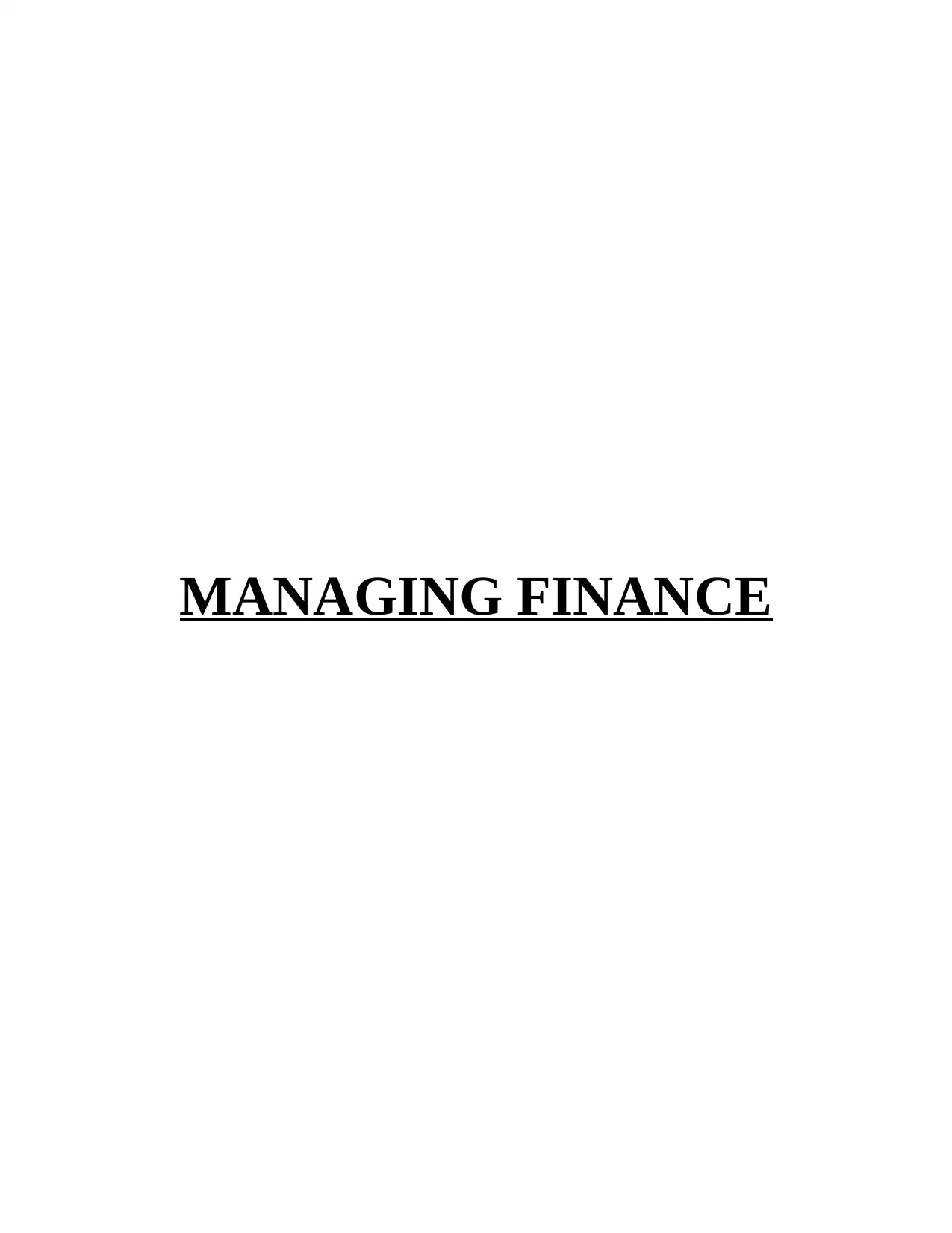
MANAGING FINANCE
Paraphrase This Document
Need a fresh take? Get an instant paraphrase of this document with our AI Paraphraser

Table of Contents
INTRODUCTION...........................................................................................................................3
MAIN BODY ..................................................................................................................................3
Relationship between financial and other functional areas within organizations........................4
Impact of financial objectives on decision-making.....................................................................6
Difference between management accounting and financial accounting......................................7
Impact of organizational and regulatory frameworks on financial management approaches.....8
Financial challenges faced by the organization...........................................................................9
The differences between budget setting and financial forecasting............................................10
Evaluations of budget methods used by the organizations........................................................12
Formulation and justification of budget for an area of management responsibility..................14
Analysing the impact of different factors on budget management............................................16
Corrective actions in response to budgetary variance................................................................17
Reporting procedures for authorizing corrective actions to a budget........................................18
CONCLUSION..............................................................................................................................19
REFERENCES................................................................................................................................1
INTRODUCTION...........................................................................................................................3
MAIN BODY ..................................................................................................................................3
Relationship between financial and other functional areas within organizations........................4
Impact of financial objectives on decision-making.....................................................................6
Difference between management accounting and financial accounting......................................7
Impact of organizational and regulatory frameworks on financial management approaches.....8
Financial challenges faced by the organization...........................................................................9
The differences between budget setting and financial forecasting............................................10
Evaluations of budget methods used by the organizations........................................................12
Formulation and justification of budget for an area of management responsibility..................14
Analysing the impact of different factors on budget management............................................16
Corrective actions in response to budgetary variance................................................................17
Reporting procedures for authorizing corrective actions to a budget........................................18
CONCLUSION..............................................................................................................................19
REFERENCES................................................................................................................................1
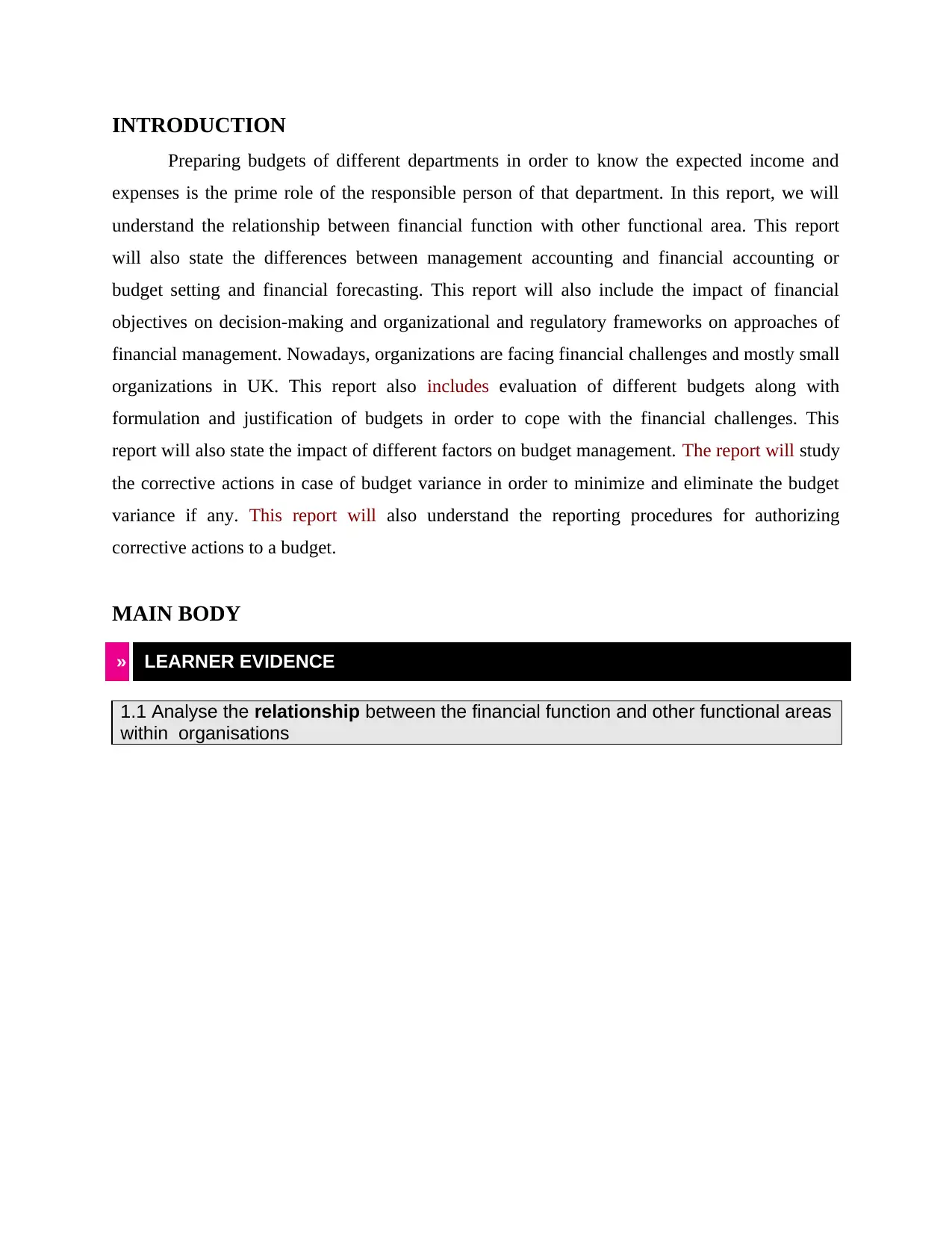
INTRODUCTION
Preparing budgets of different departments in order to know the expected income and
expenses is the prime role of the responsible person of that department. In this report, we will
understand the relationship between financial function with other functional area. This report
will also state the differences between management accounting and financial accounting or
budget setting and financial forecasting. This report will also include the impact of financial
objectives on decision-making and organizational and regulatory frameworks on approaches of
financial management. Nowadays, organizations are facing financial challenges and mostly small
organizations in UK. This report also includes evaluation of different budgets along with
formulation and justification of budgets in order to cope with the financial challenges. This
report will also state the impact of different factors on budget management. The report will study
the corrective actions in case of budget variance in order to minimize and eliminate the budget
variance if any. This report will also understand the reporting procedures for authorizing
corrective actions to a budget.
MAIN BODY
» LEARNER EVIDENCE
1.1 Analyse the relationship between the financial function and other functional areas
within organisations
Preparing budgets of different departments in order to know the expected income and
expenses is the prime role of the responsible person of that department. In this report, we will
understand the relationship between financial function with other functional area. This report
will also state the differences between management accounting and financial accounting or
budget setting and financial forecasting. This report will also include the impact of financial
objectives on decision-making and organizational and regulatory frameworks on approaches of
financial management. Nowadays, organizations are facing financial challenges and mostly small
organizations in UK. This report also includes evaluation of different budgets along with
formulation and justification of budgets in order to cope with the financial challenges. This
report will also state the impact of different factors on budget management. The report will study
the corrective actions in case of budget variance in order to minimize and eliminate the budget
variance if any. This report will also understand the reporting procedures for authorizing
corrective actions to a budget.
MAIN BODY
» LEARNER EVIDENCE
1.1 Analyse the relationship between the financial function and other functional areas
within organisations
⊘ This is a preview!⊘
Do you want full access?
Subscribe today to unlock all pages.

Trusted by 1+ million students worldwide
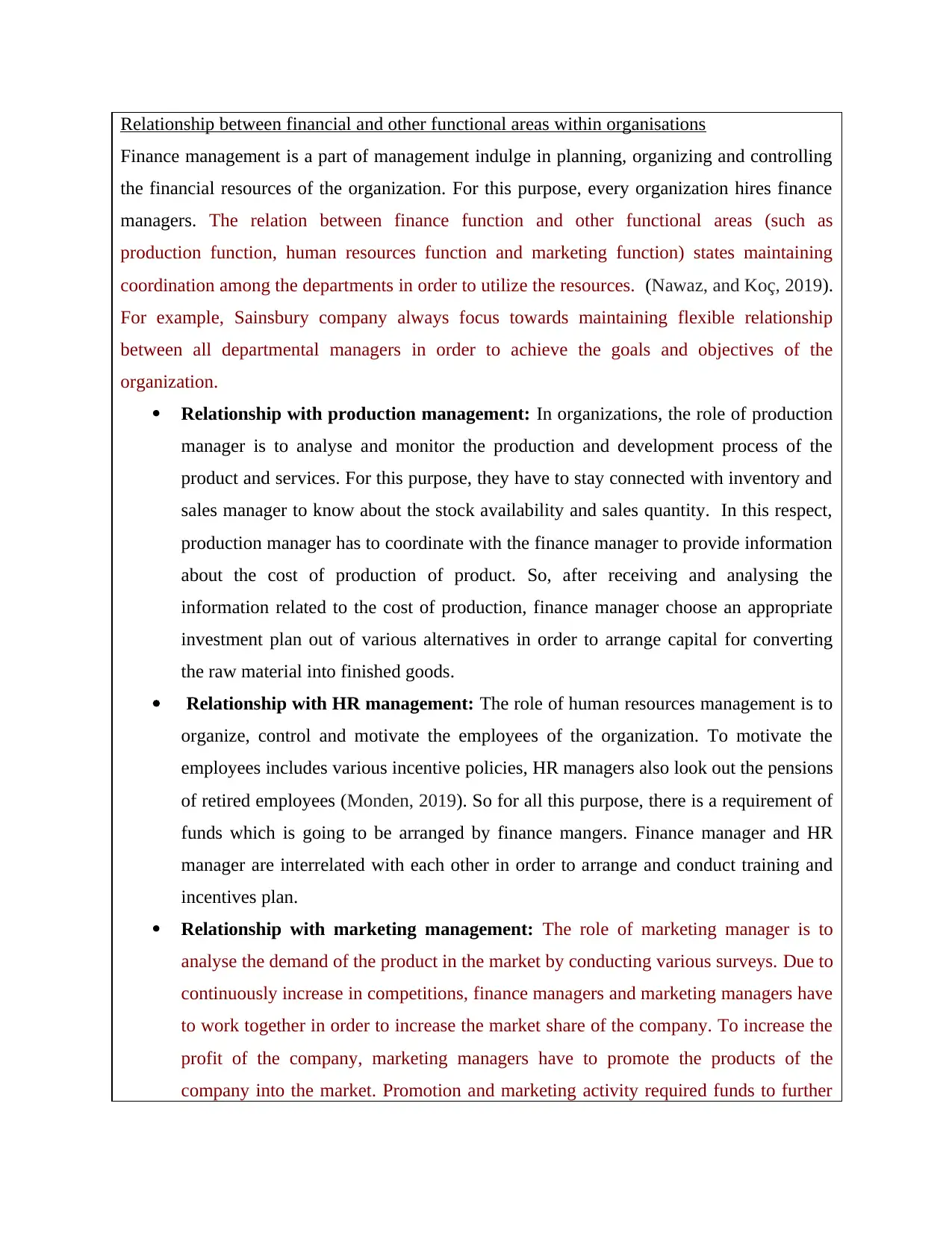
Relationship between financial and other functional areas within organisations
Finance management is a part of management indulge in planning, organizing and controlling
the financial resources of the organization. For this purpose, every organization hires finance
managers. The relation between finance function and other functional areas (such as
production function, human resources function and marketing function) states maintaining
coordination among the departments in order to utilize the resources. (Nawaz, and Koç, 2019).
For example, Sainsbury company always focus towards maintaining flexible relationship
between all departmental managers in order to achieve the goals and objectives of the
organization.
Relationship with production management: In organizations, the role of production
manager is to analyse and monitor the production and development process of the
product and services. For this purpose, they have to stay connected with inventory and
sales manager to know about the stock availability and sales quantity. In this respect,
production manager has to coordinate with the finance manager to provide information
about the cost of production of product. So, after receiving and analysing the
information related to the cost of production, finance manager choose an appropriate
investment plan out of various alternatives in order to arrange capital for converting
the raw material into finished goods.
Relationship with HR management: The role of human resources management is to
organize, control and motivate the employees of the organization. To motivate the
employees includes various incentive policies, HR managers also look out the pensions
of retired employees (Monden, 2019). So for all this purpose, there is a requirement of
funds which is going to be arranged by finance mangers. Finance manager and HR
manager are interrelated with each other in order to arrange and conduct training and
incentives plan.
Relationship with marketing management: The role of marketing manager is to
analyse the demand of the product in the market by conducting various surveys. Due to
continuously increase in competitions, finance managers and marketing managers have
to work together in order to increase the market share of the company. To increase the
profit of the company, marketing managers have to promote the products of the
company into the market. Promotion and marketing activity required funds to further
Finance management is a part of management indulge in planning, organizing and controlling
the financial resources of the organization. For this purpose, every organization hires finance
managers. The relation between finance function and other functional areas (such as
production function, human resources function and marketing function) states maintaining
coordination among the departments in order to utilize the resources. (Nawaz, and Koç, 2019).
For example, Sainsbury company always focus towards maintaining flexible relationship
between all departmental managers in order to achieve the goals and objectives of the
organization.
Relationship with production management: In organizations, the role of production
manager is to analyse and monitor the production and development process of the
product and services. For this purpose, they have to stay connected with inventory and
sales manager to know about the stock availability and sales quantity. In this respect,
production manager has to coordinate with the finance manager to provide information
about the cost of production of product. So, after receiving and analysing the
information related to the cost of production, finance manager choose an appropriate
investment plan out of various alternatives in order to arrange capital for converting
the raw material into finished goods.
Relationship with HR management: The role of human resources management is to
organize, control and motivate the employees of the organization. To motivate the
employees includes various incentive policies, HR managers also look out the pensions
of retired employees (Monden, 2019). So for all this purpose, there is a requirement of
funds which is going to be arranged by finance mangers. Finance manager and HR
manager are interrelated with each other in order to arrange and conduct training and
incentives plan.
Relationship with marketing management: The role of marketing manager is to
analyse the demand of the product in the market by conducting various surveys. Due to
continuously increase in competitions, finance managers and marketing managers have
to work together in order to increase the market share of the company. To increase the
profit of the company, marketing managers have to promote the products of the
company into the market. Promotion and marketing activity required funds to further
Paraphrase This Document
Need a fresh take? Get an instant paraphrase of this document with our AI Paraphraser
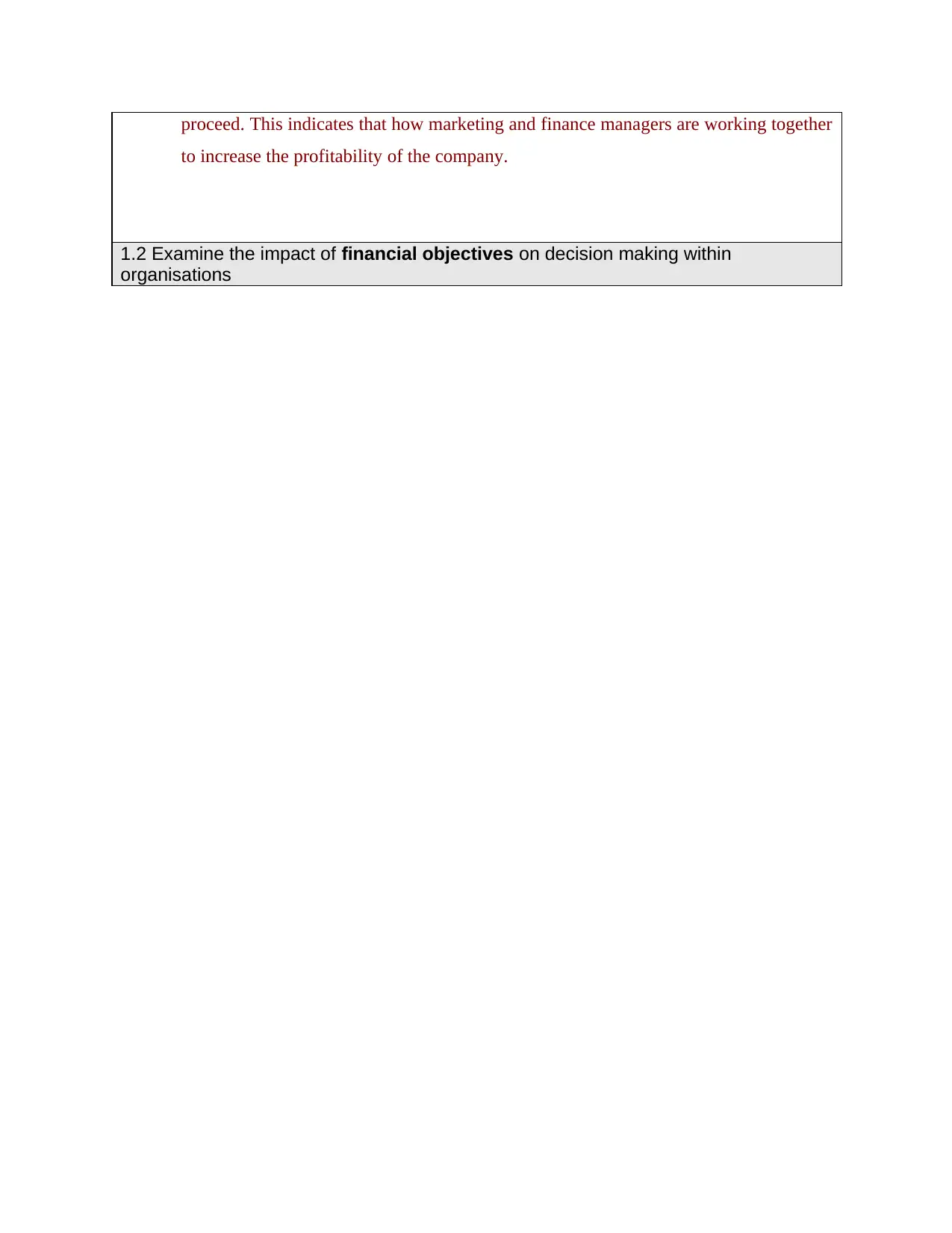
proceed. This indicates that how marketing and finance managers are working together
to increase the profitability of the company.
1.2 Examine the impact of financial objectives on decision making within
organisations
to increase the profitability of the company.
1.2 Examine the impact of financial objectives on decision making within
organisations
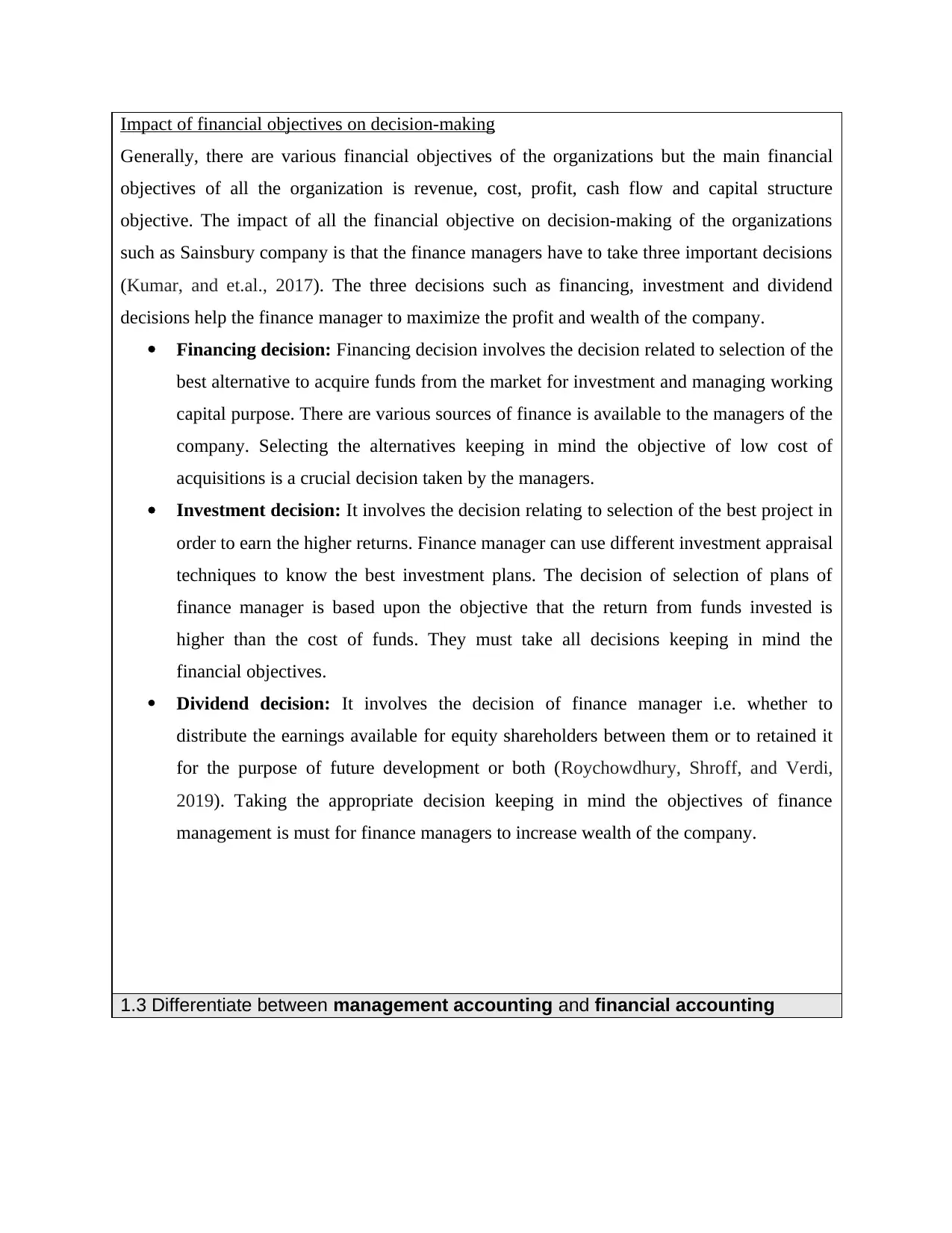
Impact of financial objectives on decision-making
Generally, there are various financial objectives of the organizations but the main financial
objectives of all the organization is revenue, cost, profit, cash flow and capital structure
objective. The impact of all the financial objective on decision-making of the organizations
such as Sainsbury company is that the finance managers have to take three important decisions
(Kumar, and et.al., 2017). The three decisions such as financing, investment and dividend
decisions help the finance manager to maximize the profit and wealth of the company.
Financing decision: Financing decision involves the decision related to selection of the
best alternative to acquire funds from the market for investment and managing working
capital purpose. There are various sources of finance is available to the managers of the
company. Selecting the alternatives keeping in mind the objective of low cost of
acquisitions is a crucial decision taken by the managers.
Investment decision: It involves the decision relating to selection of the best project in
order to earn the higher returns. Finance manager can use different investment appraisal
techniques to know the best investment plans. The decision of selection of plans of
finance manager is based upon the objective that the return from funds invested is
higher than the cost of funds. They must take all decisions keeping in mind the
financial objectives.
Dividend decision: It involves the decision of finance manager i.e. whether to
distribute the earnings available for equity shareholders between them or to retained it
for the purpose of future development or both (Roychowdhury, Shroff, and Verdi,
2019). Taking the appropriate decision keeping in mind the objectives of finance
management is must for finance managers to increase wealth of the company.
1.3 Differentiate between management accounting and financial accounting
Generally, there are various financial objectives of the organizations but the main financial
objectives of all the organization is revenue, cost, profit, cash flow and capital structure
objective. The impact of all the financial objective on decision-making of the organizations
such as Sainsbury company is that the finance managers have to take three important decisions
(Kumar, and et.al., 2017). The three decisions such as financing, investment and dividend
decisions help the finance manager to maximize the profit and wealth of the company.
Financing decision: Financing decision involves the decision related to selection of the
best alternative to acquire funds from the market for investment and managing working
capital purpose. There are various sources of finance is available to the managers of the
company. Selecting the alternatives keeping in mind the objective of low cost of
acquisitions is a crucial decision taken by the managers.
Investment decision: It involves the decision relating to selection of the best project in
order to earn the higher returns. Finance manager can use different investment appraisal
techniques to know the best investment plans. The decision of selection of plans of
finance manager is based upon the objective that the return from funds invested is
higher than the cost of funds. They must take all decisions keeping in mind the
financial objectives.
Dividend decision: It involves the decision of finance manager i.e. whether to
distribute the earnings available for equity shareholders between them or to retained it
for the purpose of future development or both (Roychowdhury, Shroff, and Verdi,
2019). Taking the appropriate decision keeping in mind the objectives of finance
management is must for finance managers to increase wealth of the company.
1.3 Differentiate between management accounting and financial accounting
⊘ This is a preview!⊘
Do you want full access?
Subscribe today to unlock all pages.

Trusted by 1+ million students worldwide
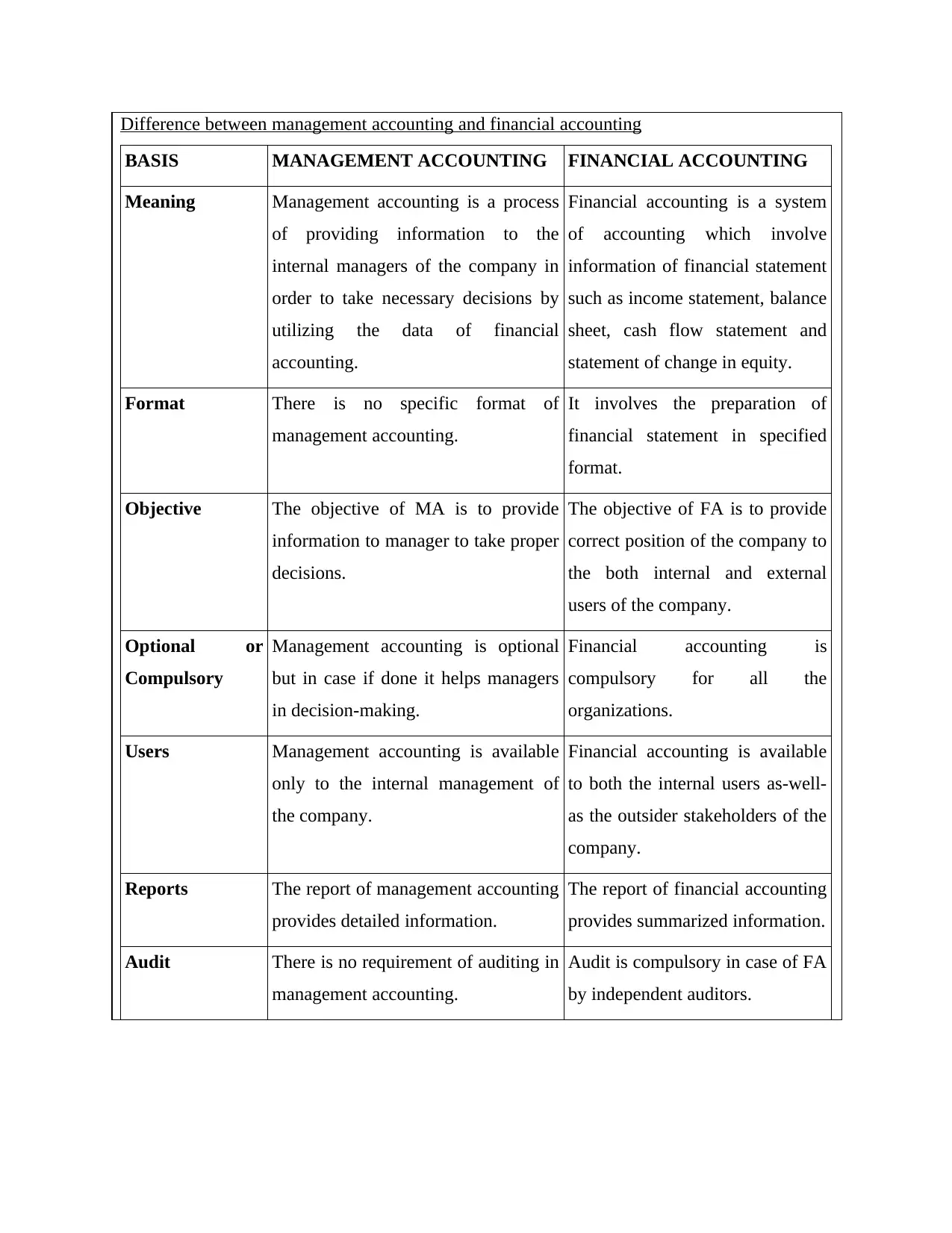
Difference between management accounting and financial accounting
BASIS MANAGEMENT ACCOUNTING FINANCIAL ACCOUNTING
Meaning Management accounting is a process
of providing information to the
internal managers of the company in
order to take necessary decisions by
utilizing the data of financial
accounting.
Financial accounting is a system
of accounting which involve
information of financial statement
such as income statement, balance
sheet, cash flow statement and
statement of change in equity.
Format There is no specific format of
management accounting.
It involves the preparation of
financial statement in specified
format.
Objective The objective of MA is to provide
information to manager to take proper
decisions.
The objective of FA is to provide
correct position of the company to
the both internal and external
users of the company.
Optional or
Compulsory
Management accounting is optional
but in case if done it helps managers
in decision-making.
Financial accounting is
compulsory for all the
organizations.
Users Management accounting is available
only to the internal management of
the company.
Financial accounting is available
to both the internal users as-well-
as the outsider stakeholders of the
company.
Reports The report of management accounting
provides detailed information.
The report of financial accounting
provides summarized information.
Audit There is no requirement of auditing in
management accounting.
Audit is compulsory in case of FA
by independent auditors.
BASIS MANAGEMENT ACCOUNTING FINANCIAL ACCOUNTING
Meaning Management accounting is a process
of providing information to the
internal managers of the company in
order to take necessary decisions by
utilizing the data of financial
accounting.
Financial accounting is a system
of accounting which involve
information of financial statement
such as income statement, balance
sheet, cash flow statement and
statement of change in equity.
Format There is no specific format of
management accounting.
It involves the preparation of
financial statement in specified
format.
Objective The objective of MA is to provide
information to manager to take proper
decisions.
The objective of FA is to provide
correct position of the company to
the both internal and external
users of the company.
Optional or
Compulsory
Management accounting is optional
but in case if done it helps managers
in decision-making.
Financial accounting is
compulsory for all the
organizations.
Users Management accounting is available
only to the internal management of
the company.
Financial accounting is available
to both the internal users as-well-
as the outsider stakeholders of the
company.
Reports The report of management accounting
provides detailed information.
The report of financial accounting
provides summarized information.
Audit There is no requirement of auditing in
management accounting.
Audit is compulsory in case of FA
by independent auditors.
Paraphrase This Document
Need a fresh take? Get an instant paraphrase of this document with our AI Paraphraser
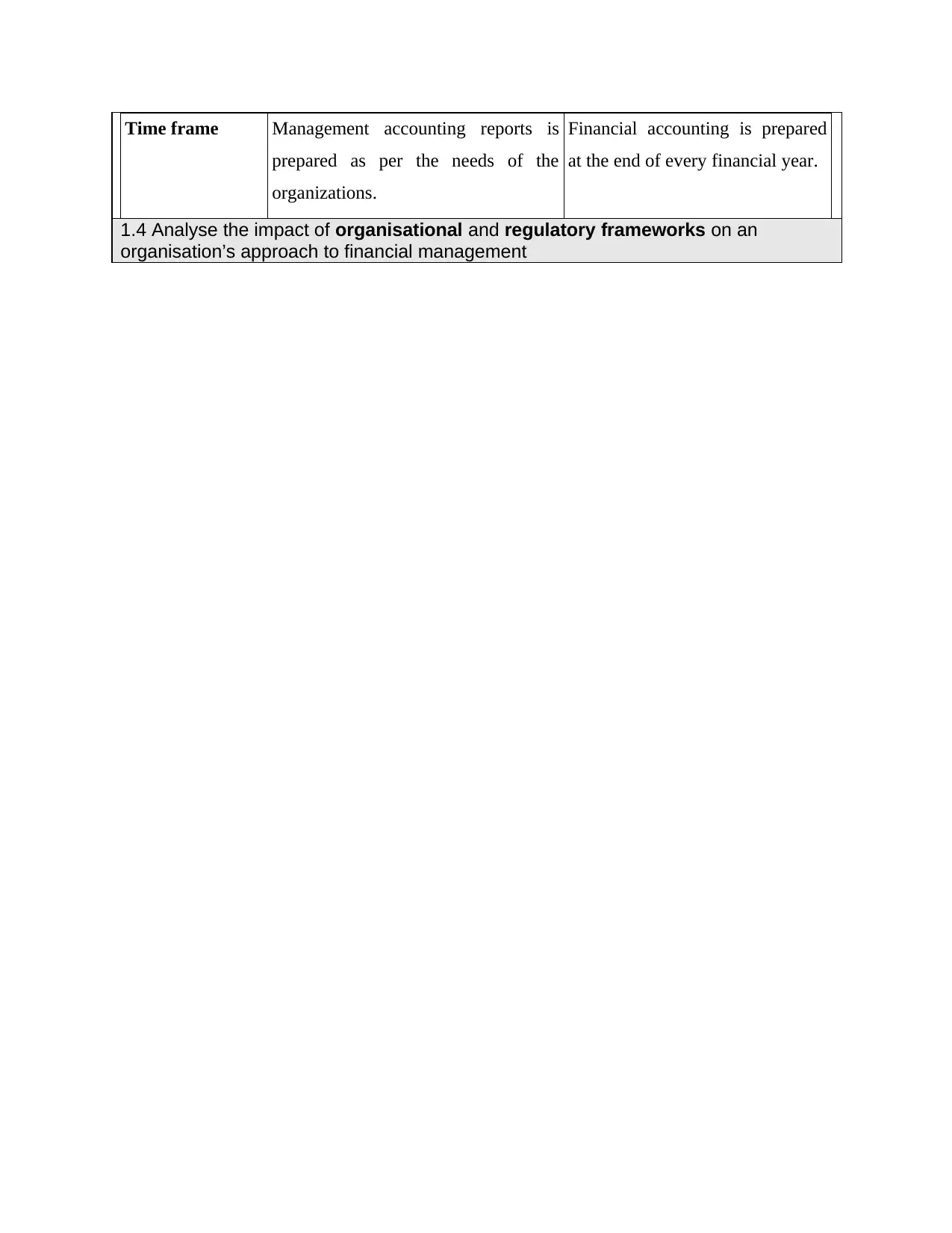
Time frame Management accounting reports is
prepared as per the needs of the
organizations.
Financial accounting is prepared
at the end of every financial year.
1.4 Analyse the impact of organisational and regulatory frameworks on an
organisation’s approach to financial management
prepared as per the needs of the
organizations.
Financial accounting is prepared
at the end of every financial year.
1.4 Analyse the impact of organisational and regulatory frameworks on an
organisation’s approach to financial management
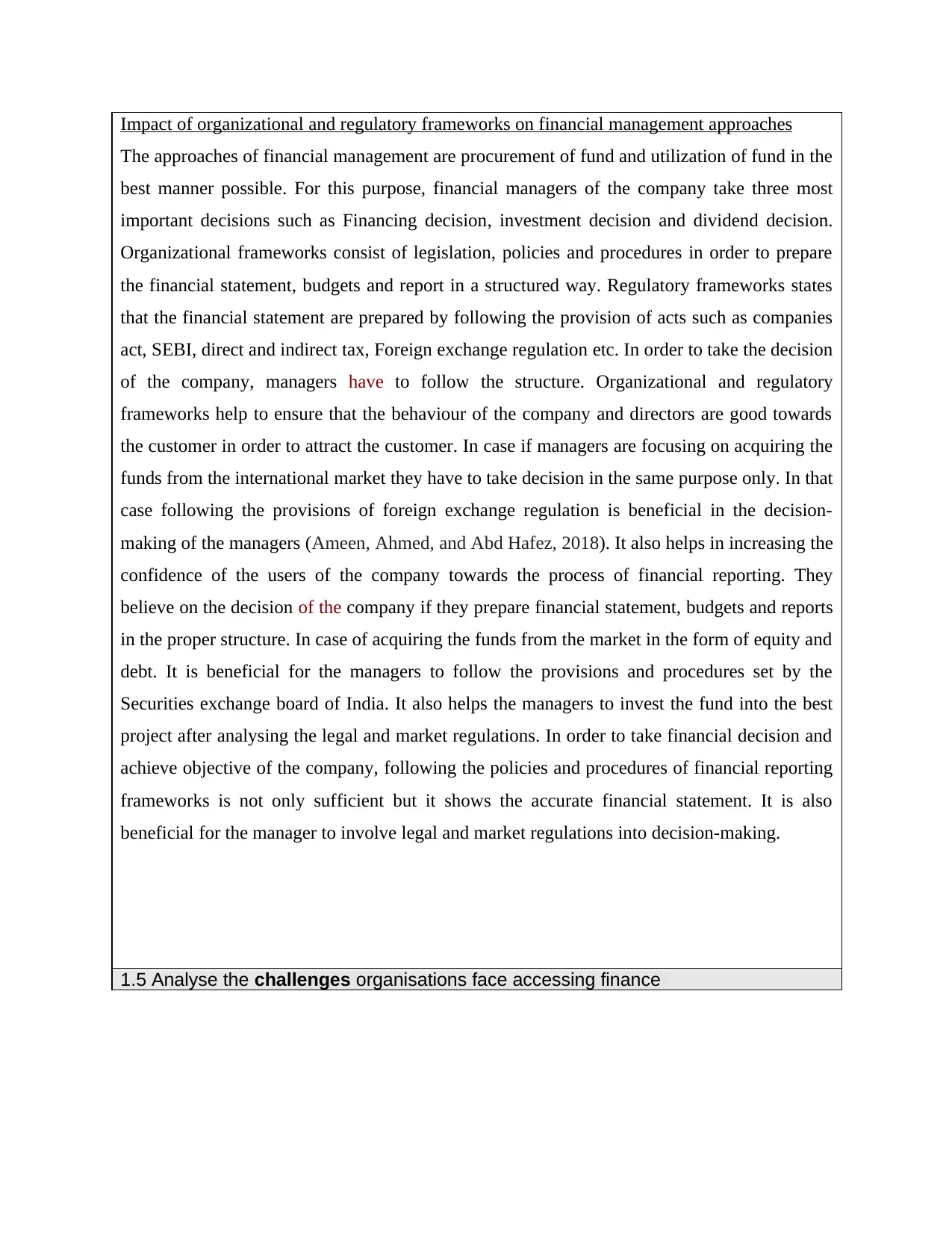
Impact of organizational and regulatory frameworks on financial management approaches
The approaches of financial management are procurement of fund and utilization of fund in the
best manner possible. For this purpose, financial managers of the company take three most
important decisions such as Financing decision, investment decision and dividend decision.
Organizational frameworks consist of legislation, policies and procedures in order to prepare
the financial statement, budgets and report in a structured way. Regulatory frameworks states
that the financial statement are prepared by following the provision of acts such as companies
act, SEBI, direct and indirect tax, Foreign exchange regulation etc. In order to take the decision
of the company, managers have to follow the structure. Organizational and regulatory
frameworks help to ensure that the behaviour of the company and directors are good towards
the customer in order to attract the customer. In case if managers are focusing on acquiring the
funds from the international market they have to take decision in the same purpose only. In that
case following the provisions of foreign exchange regulation is beneficial in the decision-
making of the managers (Ameen, Ahmed, and Abd Hafez, 2018). It also helps in increasing the
confidence of the users of the company towards the process of financial reporting. They
believe on the decision of the company if they prepare financial statement, budgets and reports
in the proper structure. In case of acquiring the funds from the market in the form of equity and
debt. It is beneficial for the managers to follow the provisions and procedures set by the
Securities exchange board of India. It also helps the managers to invest the fund into the best
project after analysing the legal and market regulations. In order to take financial decision and
achieve objective of the company, following the policies and procedures of financial reporting
frameworks is not only sufficient but it shows the accurate financial statement. It is also
beneficial for the manager to involve legal and market regulations into decision-making.
1.5 Analyse the challenges organisations face accessing finance
The approaches of financial management are procurement of fund and utilization of fund in the
best manner possible. For this purpose, financial managers of the company take three most
important decisions such as Financing decision, investment decision and dividend decision.
Organizational frameworks consist of legislation, policies and procedures in order to prepare
the financial statement, budgets and report in a structured way. Regulatory frameworks states
that the financial statement are prepared by following the provision of acts such as companies
act, SEBI, direct and indirect tax, Foreign exchange regulation etc. In order to take the decision
of the company, managers have to follow the structure. Organizational and regulatory
frameworks help to ensure that the behaviour of the company and directors are good towards
the customer in order to attract the customer. In case if managers are focusing on acquiring the
funds from the international market they have to take decision in the same purpose only. In that
case following the provisions of foreign exchange regulation is beneficial in the decision-
making of the managers (Ameen, Ahmed, and Abd Hafez, 2018). It also helps in increasing the
confidence of the users of the company towards the process of financial reporting. They
believe on the decision of the company if they prepare financial statement, budgets and reports
in the proper structure. In case of acquiring the funds from the market in the form of equity and
debt. It is beneficial for the managers to follow the provisions and procedures set by the
Securities exchange board of India. It also helps the managers to invest the fund into the best
project after analysing the legal and market regulations. In order to take financial decision and
achieve objective of the company, following the policies and procedures of financial reporting
frameworks is not only sufficient but it shows the accurate financial statement. It is also
beneficial for the manager to involve legal and market regulations into decision-making.
1.5 Analyse the challenges organisations face accessing finance
⊘ This is a preview!⊘
Do you want full access?
Subscribe today to unlock all pages.

Trusted by 1+ million students worldwide
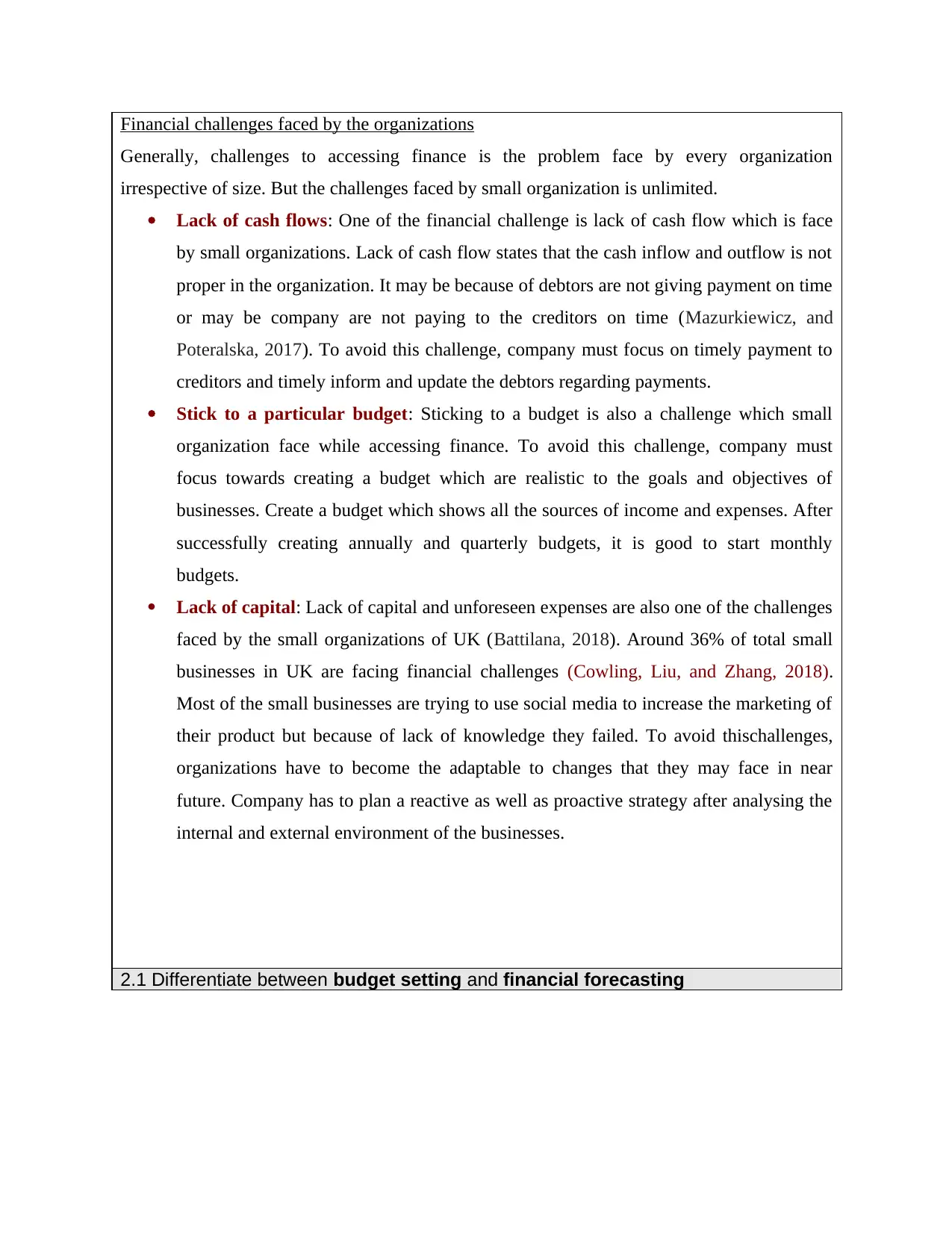
Financial challenges faced by the organizations
Generally, challenges to accessing finance is the problem face by every organization
irrespective of size. But the challenges faced by small organization is unlimited.
Lack of cash flows: One of the financial challenge is lack of cash flow which is face
by small organizations. Lack of cash flow states that the cash inflow and outflow is not
proper in the organization. It may be because of debtors are not giving payment on time
or may be company are not paying to the creditors on time (Mazurkiewicz, and
Poteralska, 2017). To avoid this challenge, company must focus on timely payment to
creditors and timely inform and update the debtors regarding payments.
Stick to a particular budget: Sticking to a budget is also a challenge which small
organization face while accessing finance. To avoid this challenge, company must
focus towards creating a budget which are realistic to the goals and objectives of
businesses. Create a budget which shows all the sources of income and expenses. After
successfully creating annually and quarterly budgets, it is good to start monthly
budgets.
Lack of capital: Lack of capital and unforeseen expenses are also one of the challenges
faced by the small organizations of UK (Battilana, 2018). Around 36% of total small
businesses in UK are facing financial challenges (Cowling, Liu, and Zhang, 2018).
Most of the small businesses are trying to use social media to increase the marketing of
their product but because of lack of knowledge they failed. To avoid thischallenges,
organizations have to become the adaptable to changes that they may face in near
future. Company has to plan a reactive as well as proactive strategy after analysing the
internal and external environment of the businesses.
2.1 Differentiate between budget setting and financial forecasting
Generally, challenges to accessing finance is the problem face by every organization
irrespective of size. But the challenges faced by small organization is unlimited.
Lack of cash flows: One of the financial challenge is lack of cash flow which is face
by small organizations. Lack of cash flow states that the cash inflow and outflow is not
proper in the organization. It may be because of debtors are not giving payment on time
or may be company are not paying to the creditors on time (Mazurkiewicz, and
Poteralska, 2017). To avoid this challenge, company must focus on timely payment to
creditors and timely inform and update the debtors regarding payments.
Stick to a particular budget: Sticking to a budget is also a challenge which small
organization face while accessing finance. To avoid this challenge, company must
focus towards creating a budget which are realistic to the goals and objectives of
businesses. Create a budget which shows all the sources of income and expenses. After
successfully creating annually and quarterly budgets, it is good to start monthly
budgets.
Lack of capital: Lack of capital and unforeseen expenses are also one of the challenges
faced by the small organizations of UK (Battilana, 2018). Around 36% of total small
businesses in UK are facing financial challenges (Cowling, Liu, and Zhang, 2018).
Most of the small businesses are trying to use social media to increase the marketing of
their product but because of lack of knowledge they failed. To avoid thischallenges,
organizations have to become the adaptable to changes that they may face in near
future. Company has to plan a reactive as well as proactive strategy after analysing the
internal and external environment of the businesses.
2.1 Differentiate between budget setting and financial forecasting
Paraphrase This Document
Need a fresh take? Get an instant paraphrase of this document with our AI Paraphraser
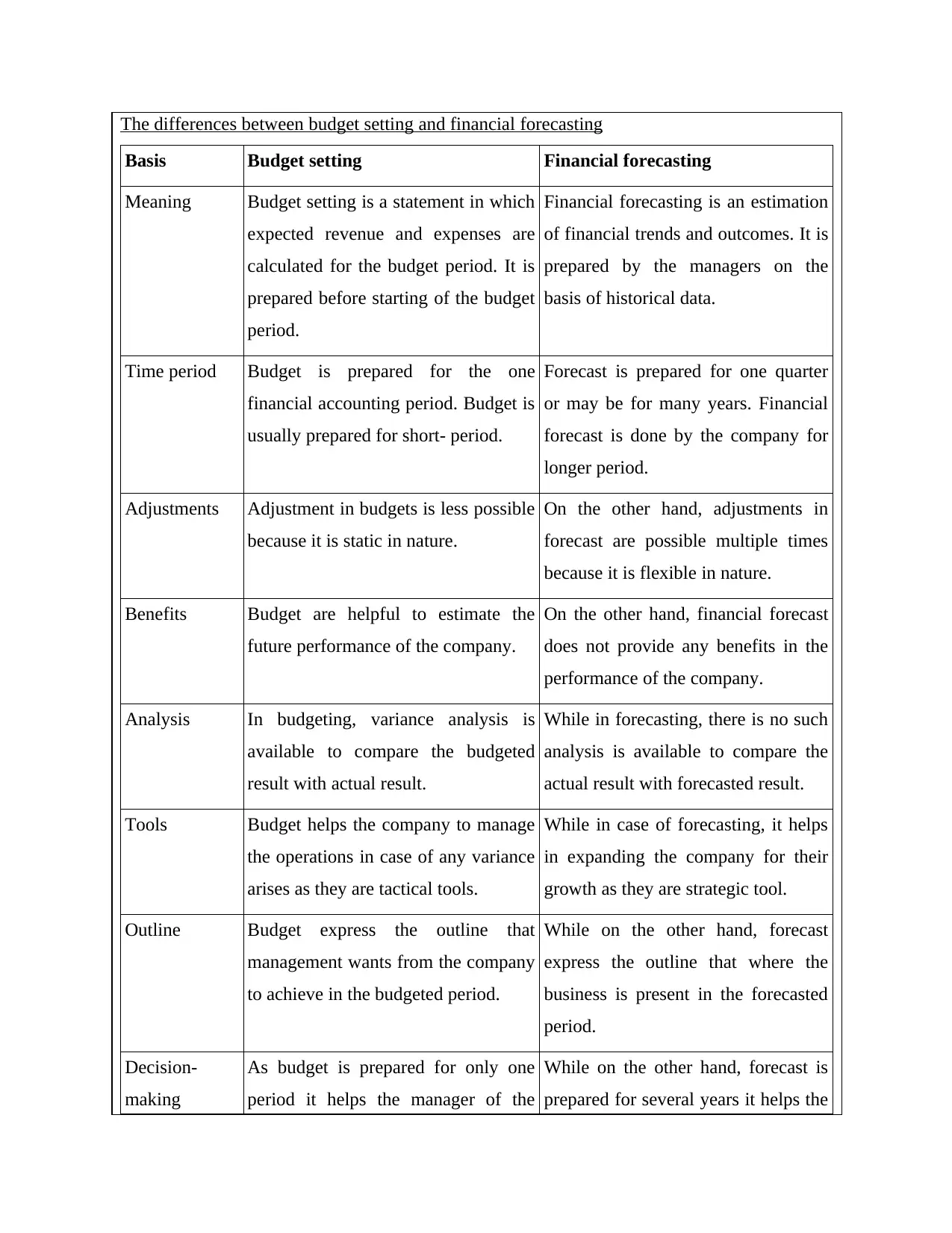
The differences between budget setting and financial forecasting
Basis Budget setting Financial forecasting
Meaning Budget setting is a statement in which
expected revenue and expenses are
calculated for the budget period. It is
prepared before starting of the budget
period.
Financial forecasting is an estimation
of financial trends and outcomes. It is
prepared by the managers on the
basis of historical data.
Time period Budget is prepared for the one
financial accounting period. Budget is
usually prepared for short- period.
Forecast is prepared for one quarter
or may be for many years. Financial
forecast is done by the company for
longer period.
Adjustments Adjustment in budgets is less possible
because it is static in nature.
On the other hand, adjustments in
forecast are possible multiple times
because it is flexible in nature.
Benefits Budget are helpful to estimate the
future performance of the company.
On the other hand, financial forecast
does not provide any benefits in the
performance of the company.
Analysis In budgeting, variance analysis is
available to compare the budgeted
result with actual result.
While in forecasting, there is no such
analysis is available to compare the
actual result with forecasted result.
Tools Budget helps the company to manage
the operations in case of any variance
arises as they are tactical tools.
While in case of forecasting, it helps
in expanding the company for their
growth as they are strategic tool.
Outline Budget express the outline that
management wants from the company
to achieve in the budgeted period.
While on the other hand, forecast
express the outline that where the
business is present in the forecasted
period.
Decision-
making
As budget is prepared for only one
period it helps the manager of the
While on the other hand, forecast is
prepared for several years it helps the
Basis Budget setting Financial forecasting
Meaning Budget setting is a statement in which
expected revenue and expenses are
calculated for the budget period. It is
prepared before starting of the budget
period.
Financial forecasting is an estimation
of financial trends and outcomes. It is
prepared by the managers on the
basis of historical data.
Time period Budget is prepared for the one
financial accounting period. Budget is
usually prepared for short- period.
Forecast is prepared for one quarter
or may be for many years. Financial
forecast is done by the company for
longer period.
Adjustments Adjustment in budgets is less possible
because it is static in nature.
On the other hand, adjustments in
forecast are possible multiple times
because it is flexible in nature.
Benefits Budget are helpful to estimate the
future performance of the company.
On the other hand, financial forecast
does not provide any benefits in the
performance of the company.
Analysis In budgeting, variance analysis is
available to compare the budgeted
result with actual result.
While in forecasting, there is no such
analysis is available to compare the
actual result with forecasted result.
Tools Budget helps the company to manage
the operations in case of any variance
arises as they are tactical tools.
While in case of forecasting, it helps
in expanding the company for their
growth as they are strategic tool.
Outline Budget express the outline that
management wants from the company
to achieve in the budgeted period.
While on the other hand, forecast
express the outline that where the
business is present in the forecasted
period.
Decision-
making
As budget is prepared for only one
period it helps the manager of the
While on the other hand, forecast is
prepared for several years it helps the
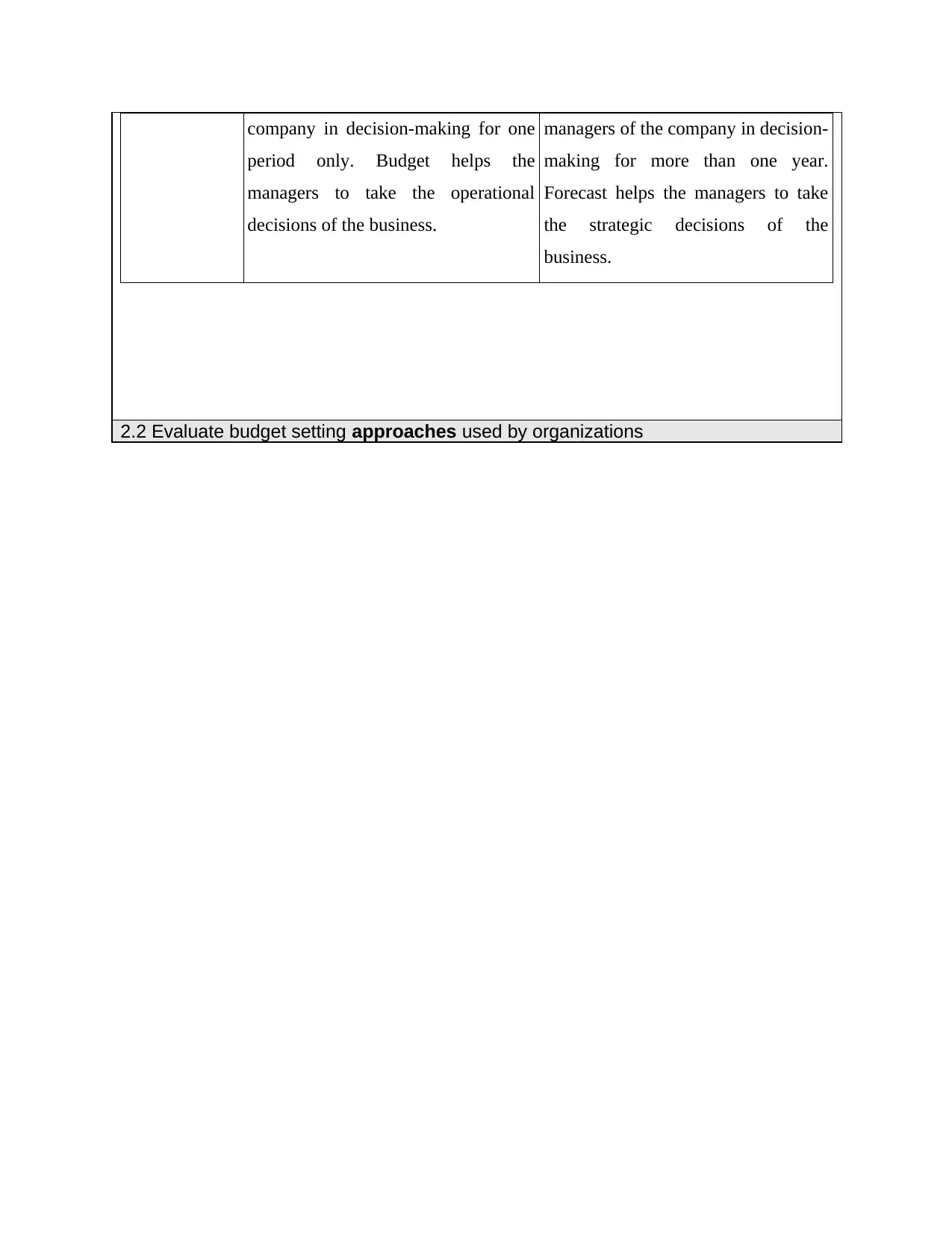
company in decision-making for one
period only. Budget helps the
managers to take the operational
decisions of the business.
managers of the company in decision-
making for more than one year.
Forecast helps the managers to take
the strategic decisions of the
business.
2.2 Evaluate budget setting approaches used by organizations
period only. Budget helps the
managers to take the operational
decisions of the business.
managers of the company in decision-
making for more than one year.
Forecast helps the managers to take
the strategic decisions of the
business.
2.2 Evaluate budget setting approaches used by organizations
⊘ This is a preview!⊘
Do you want full access?
Subscribe today to unlock all pages.

Trusted by 1+ million students worldwide
1 out of 23
Related Documents
Your All-in-One AI-Powered Toolkit for Academic Success.
+13062052269
info@desklib.com
Available 24*7 on WhatsApp / Email
![[object Object]](/_next/static/media/star-bottom.7253800d.svg)
Unlock your academic potential
Copyright © 2020–2025 A2Z Services. All Rights Reserved. Developed and managed by ZUCOL.





